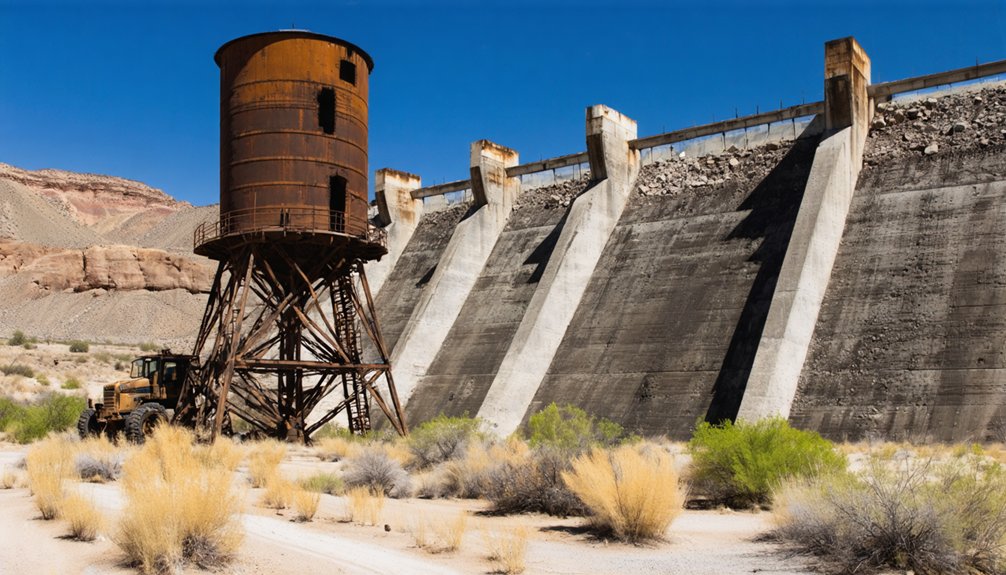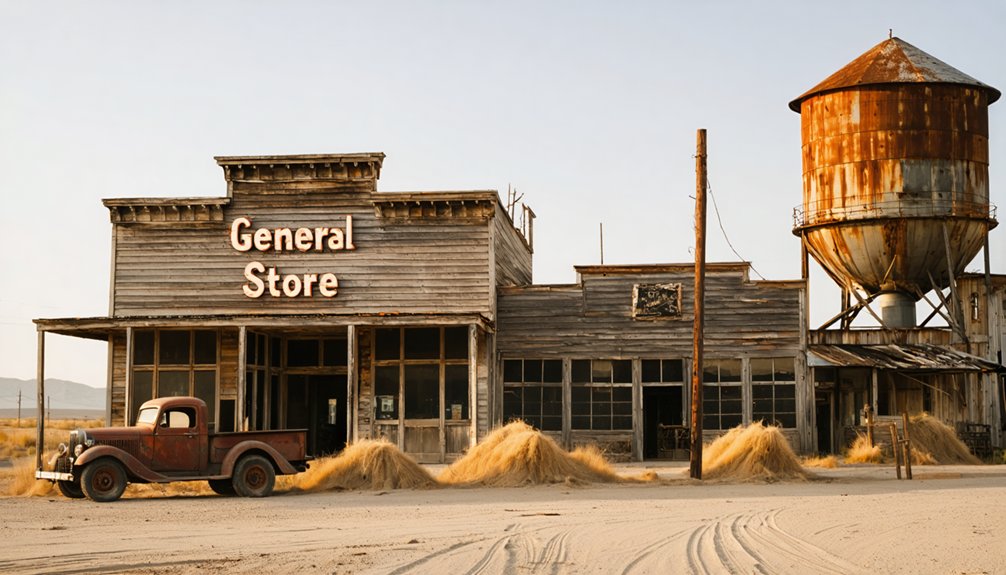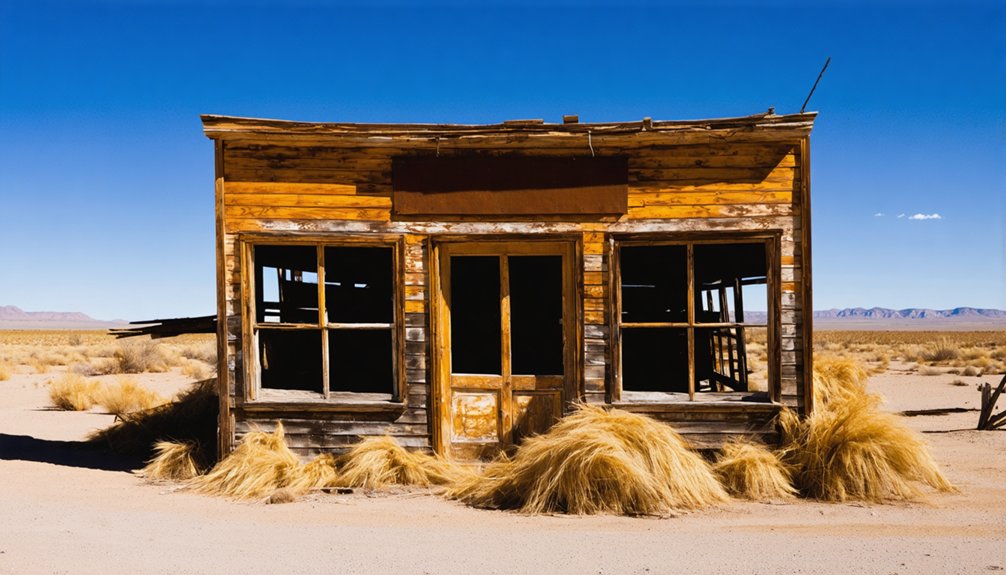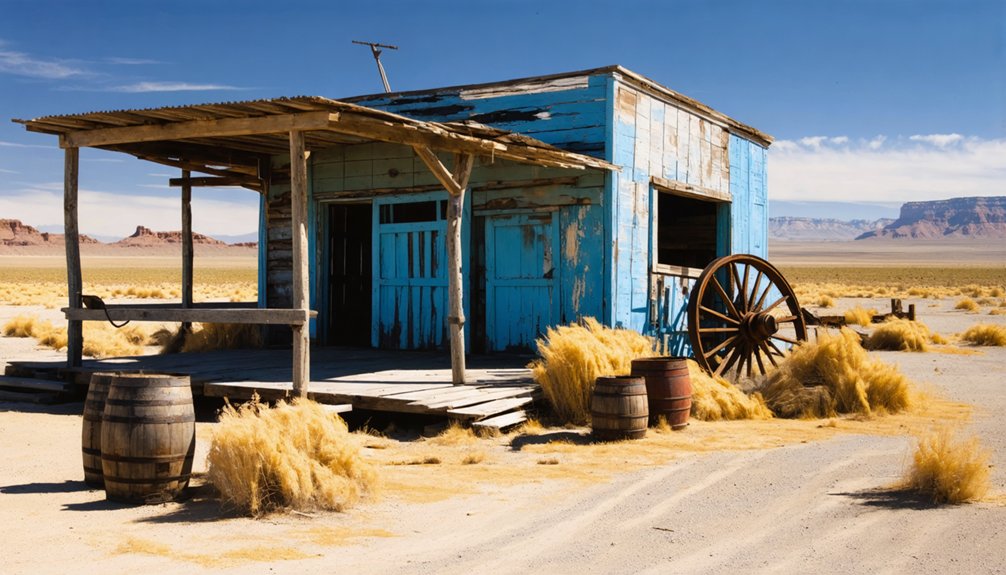Brigham City, Arizona was a Mormon settlement founded in 1876 along the Little Colorado River. You’ll find remains of a community that once thrived behind seven-foot adobe walls, operating under the communal United Order system. Despite their cooperative efforts, the settlement faced devastating dam failures and water management issues, leading to its abandonment by 1881. Today, only ruins and a cemetery remain as evidence of these pioneers’ brief but determined experiment in desert colonization.
Key Takeaways
- Brigham City was established in 1876 as a Mormon settlement along the Little Colorado River before being abandoned in 1881.
- The community operated under the United Order system with communal ownership of property and shared meals at “the big table.”
- Seven-foot adobe walls surrounded the settlement, which housed up to 191 residents during its brief existence.
- Repeated dam failures and flooding destroyed crops, leading to economic collapse and the settlement’s ultimate abandonment.
- Only one original building remains at the site, which received National Register of Historic Places status in 1978.
The Mormon Vision of Western Expansion
When Brigham Young led the Mormon migration westward in the mid-nineteenth century, he was driven by a powerful religious vision that went beyond mere territorial expansion. He sought to establish “Zion,” a divinely ordained refuge where Latter-day Saints could practice their faith free from the persecution they’d faced in the East.
This westward expansion was understood as fulfilling divine prophecy, with Young cast as a modern-day Moses leading his people to the promised land. The Mormon migration wasn’t just about finding new homes—it was about creating a new society based on religious principles and cooperative labor.
You can see how this vision aligned with America’s broader Manifest Destiny concept while maintaining its distinct religious character. The settlements that emerged were designed to be self-sufficient communities where Saints could thrive according to their religious ideals. Young carefully organized the journey from Winter Quarters in 1846-1847, consulting with experts and creating detailed plans for the challenging migration ahead. After Smith’s martyrdom in 1844, Young emerged as the leader who would guide the fractured Mormon community to establish what they initially called Deseret in the Salt Lake Valley.
From Ballinger’s Camp to Brigham City: A Settlement’s Birth
When you trace Brigham City‘s origins, you’ll find it began in April 1876 as “Ballinger’s Camp,” named for its leader Jessie O. Ballinger who led Mormon settlers to this northern Arizona site.
The settlement would retain this name for two years before being renamed Brigham City in 1878, honoring the Mormon Church‘s president Brigham Young.
This founding represented a strategic piece of the larger LDS Church vision to establish a network of colonies along the Little Colorado River, creating an important transportation corridor through eastern Arizona Territory.
The Brigham City settlement faced significant challenges, including poor crop yields due to frequently washed-out dams along the Little Colorado River.
Like other early settlements in the area, Brigham City adopted the United Order lifestyle, emphasizing communal work, shared resources, and cooperative living arrangements among its pioneer residents.
Pre-Mormon Naming Origins
Before the area became known as Brigham City, the settlement began as Ballinger’s Camp in April 1876, named after one of its founding leaders, Jesse O. This pre-Mormon settlement name followed the common convention of identifying pioneer communities by their leaders.
The practice helped distinguish between the four original Mormon colonies established along the Little Colorado River.
When you explore the historical naming conventions of the area, you’ll find:
- Other nearby settlements followed the same pattern (Smith’s Camp, Allen’s Camp)
- These names were primarily functional, helping to organize different pioneer groups
- As settlements evolved from temporary to permanent, names often changed to reflect their changing status
This naming tradition represented the practical approach early settlers took before formal town establishments. The town’s renaming as Brigham City aligned with Brigham Young’s vision for establishing a chain of Mormon communities in the region. The settlement was formally named Brigham City in 1878 to honor Brigham Young, the influential Mormon leader.
Settlement Founding Vision
The ambitious vision of a growing Mormon presence in northeastern Arizona materialized in April 1876 when Jesse O. Ballinger led a group of Mormon emigrants to establish Ballinger’s Camp along the Little Colorado River.
This settlement, one of four initial colonies in the valley, embodied the founding motivations of the LDS Church’s broader initiative to colonize the region.
The settlers implemented a communal vision by organizing under the United Order, pooling their resources including tools, animals, and housing while maintaining private family quarters.
Their ambitious plans extended beyond mere survival—they envisioned creating a transportation corridor stretching into Mexico.
In 1878, Ballinger’s Camp was formally renamed Brigham City, honoring the church leader Brigham Young and solidifying its place in the Church’s colonization efforts.
Life Within the Walls: Community Structure and Organization
Surrounded by adobe walls standing seven feet tall and stretching 200 feet in length, Brigham City’s residents created a tightly-knit community designed for both protection and cooperation.
Behind seven-foot adobe walls, Brigham City’s residents built a community where protection and cooperation shaped their shared existence.
Twenty Mormon families and fifteen single men organized their lives around clearly defined community roles and shared responsibilities. The settlement’s peak population reached 191 residents, all working together within the fort’s central design. Their daily activities were guided by the principles of the United Order system, which emphasized communal ownership and equitable distribution of resources. Similar to the later Intermountain Indian School, the settlement fostered cultural exchanges and shared experiences among its diverse inhabitants.
Your daily life would have included:
- Participating in communal labor through farming, construction, and maintenance
- Attending social gatherings centered around religious practices and shared meals
- Contributing to essential services in the settlement’s school, gristmill, tannery, or blacksmith shops
This structured lifestyle fostered resilience against harsh environmental conditions while creating strong community bonds among the settlers.
The United Order: Economic and Social Experiment
While daily life within Brigham City’s walls established a cooperative framework, this settlement would soon embrace a more formalized economic system that transformed its social fabric.
In 1874, under Brigham Young’s direction, the United Order was implemented, requiring residents to contribute all property, labor, and talents to the community. You’d have eaten at “the big table” where meals were shared communally, and your work—whether as a blacksmith, carpenter, or farmer—would directly benefit everyone.
Through communal resource pooling, the settlement achieved remarkable economic self-sufficiency, producing most necessities locally. The Order aimed to eliminate class distinctions and poverty by meeting everyone’s needs equally. Women in Brigham City played crucial roles managing textile production and other domestic industries essential to the community’s sustainability.
Despite its idealistic foundation, this social experiment faced significant challenges from natural disasters, leadership conflicts, and external market pressures that eventually contributed to its decline.
Battling Nature: Dam Construction and Water Management

You’ll find evidence of Brigham City’s struggle with water management in the remains of their repeatedly constructed and destroyed dam on the Little Colorado River.
Despite their persistent efforts from 1876-1880, the settlers couldn’t engineer a structure capable of withstanding the region’s violent flash floods, which washed away their dam at least three times.
These failures directly undermined the community’s agricultural foundation, creating food shortages and economic collapse that ultimately led to the settlement’s abandonment by 1881.
Repeated Dam Failures
Despite years of determined effort, Brigham City’s settlers found themselves locked in an unwinnable battle against nature’s destructive forces through the recurring failure of dams between 1876 and 1881.
The community’s dam engineering suffered from fatal flaws, particularly the inability to establish firm foundations in the deep alluvial riverbed that characterized the area.
These structural failures created a devastating cycle that ultimately doomed the settlement:
- Upstream dam collapses triggered cascade failures downstream, multiplying damage
- Near-semiannual rebuilding drained resources and labor from farming and other essential activities
- Emergency responses like blasting spillways during floods proved too little, too late
You can still find traces of these desperate water management attempts today, silent monuments to the settlers’ ultimately futile struggle against the region’s unpredictable hydrology.
Irrigation Against Odds
The dam failures that plagued Brigham City weren’t the end of settlers’ water woes, but rather one chapter in a broader struggle to establish reliable irrigation.
You’d have seen settlers digging shallow ditches by hand, extending from the Little Colorado River to their fields using basic tools and communal labor. Their irrigation techniques reflected both necessity and Mormon communal ideals.
Water conservation became an obsession as you’d witness settlers constantly monitoring flow levels to prevent wastage. The unpredictable river alternately threatened floods or drought, while waterlogging damaged low-lying fields.
Every able-bodied resident participated in the endless maintenance—clearing sediment, repairing erosion, adjusting water delivery.
Despite these challenges, their system sustained agriculture for decades, with the community’s survival entirely dependent on the effectiveness of their irrigation network against seemingly impossible odds.
Daily Life in an Arizona Desert Frontier Outpost
Life in Brigham City revolved around the communal and cooperative efforts necessary for survival in the harsh Arizona desert.
Communal cooperation became the lifeblood of Brigham City, essential for enduring the unforgiving desert landscape.
You’d find twenty Mormon families and fifteen single men living within protective adobe walls, demonstrating pioneer resilience through their daily routines. The United Order economic system governed how resources were shared, with communal bonds strengthening as residents faced repeated challenges.
Your typical day would include:
- Working in communal fields and repairing irrigation systems damaged by flash floods
- Participating in essential trades like milling, pottery making, or construction
- Attending religious gatherings that reinforced community solidarity and purpose
Daily life centered around the fort’s workshops, storage rooms, and living quarters, with residents practicing self-sufficiency despite the difficult conditions that eventually led to abandonment by 1881.
The Slow Decline: Challenges That Doomed the Settlement

When the Mormon pioneers first established Brigham City in 1876, few could have anticipated the relentless series of challenges that would eventually doom their settlement.
You’d have witnessed the community’s environmental resilience tested beyond breaking as flash floods repeatedly destroyed their dams and irrigation systems.
The settlement’s small population—only 20 families and 15 single men at its peak—struggled against a harsh desert climate that made agriculture nearly impossible.
Their communal United Order economic system buckled under frequent crop failures and limited resources.
Without railroad connections or viable trade routes, isolation intensified their hardships.
Archaeological Findings and Historical Record
At Brigham City’s archaeological site, you’ll find excavated pottery fragments and tools that reveal the settlers’ daily routines and domestic activities from the 1870s.
The recovered artifacts, including household items and religious objects, provide tangible connections to the Mormon families who attempted to create a self-sufficient community in this harsh frontier environment.
Archaeologists have documented the precise construction techniques of the settlement’s adobe walls, showing how the residents adapted traditional building methods to utilize local materials while creating the protective 7-foot barrier that once enclosed their communal experiment.
Excavation Reveals Daily Life
Archaeological excavations at Brigham City have unearthed a treasure trove of artifacts and structural remains that paint a vivid picture of pioneer life in this Arizona ghost town.
The settlement’s community dynamics centered around a fortified compound with 7-foot walls stretching 200 feet to protect residents from outside threats.
Within this protective enclosure, archaeologists have identified:
- A dedicated pottery workshop (18 ft square with flagstone floor) where craftsman Wilhelm Behrman supplied the colony
- Evidence of diverse agricultural practices supported by irrigation systems along the Little Colorado River
- Specialized work areas including a tannery, blacksmith shop, and wool-processing facilities
Only one original building survives today, but the site’s significance earned it National Register status in 1978, with ongoing restoration preserving this glimpse into frontier communal living.
Recovered Artifacts Illuminate History
The meticulous study of recovered artifacts from Brigham City’s ruins has revealed a rich tapestry of pioneer life beyond what structural remains alone could tell. Archaeological teams have unearthed porcelain door knobs, iron remnants, and bricks that demonstrate both domestic life and industrial activity in this once-thriving settlement.
In the riverbed, you’ll find evidence of daily pioneer existence through discovered buckles and other period objects. The artifact significance extends to Wilhelm Frederick Otto Behrman‘s pottery workshop, where excavations revealed an 18-foot-square space with a flagstone floor opening into a 10-foot-diameter bastion.
These findings provide essential historical context about the community established by twenty Mormon families in 1876, which grew to 191 residents by 1880 before abandonment in 1881 due to environmental challenges.
Wall Construction Techniques Documented
Pioneer ingenuity shines through the varied wall construction techniques documented at Brigham City’s remains.
You’ll notice how settlers adapted their building methods to the harsh desert environment, creating structures that balanced available materials with practical needs.
- Adobe walls formed the fort’s perimeter and many buildings, providing natural insulation despite their adobe vulnerabilities to flash floods and erosion.
- Stone durability is evident in the remaining foundations, where local masonry protected structures from ground moisture that would quickly deteriorate earthen walls.
- Wood preservation techniques were employed for framing, roof structures, and supports, while evidence suggests rammed techniques similar to those used in other regional settlements may have been utilized.
These construction methods demonstrate how pioneers thoughtfully adapted Old World building knowledge to New World desert conditions.
Visiting the Ghost Town Today: What Remains
Ghostly remnants of Brigham City stand as silent witnesses to a once-thriving Mormon settlement north of Winslow, Arizona. When visiting today, you’ll find only one original building and sections of adobe fort wall still standing.
The visitor experience is decidedly minimalist—no museum, gift shop, or modern facilities exist on this privately-owned land.
No gift shops or tourist traps here—just you, history, and privately-owned desert silence.
An interpretive trail with informational signs guides you through the settlement’s history, daily life, and ultimate abandonment. You’ll see foundations and outlines giving a sense of the original layout, plus two cemeteries with weathered headstones that tell demographic stories of the former residents.
Preservation challenges are evident throughout the site. Despite being listed on the National Register of Historic Places since 1978, erosion, weather, and time have left most of the town barely recognizable.
Legacy of the Little Colorado River Colonies

When Brigham Young directed 200 Mormon settlers to migrate south from Utah to Arizona Territory in 1876, he set in motion a significant chapter in the American Southwest’s colonization history.
These pioneers established communities like Brigham City through communal labor and shared resources, fundamentally reshaping the region’s agricultural practices and water usage patterns.
Their legacy continues in three distinct ways:
- The establishment of Mormon agriculture through innovative irrigation systems that transformed arid lands into productive farms.
- Creation of early water rights precedents that still influence modern legal frameworks in Arizona.
- Development of community structures balancing individual needs with collective responsibility.
Though many settlements became ghost towns, their influence on water management and community organization extends far beyond their brief existence, setting patterns that would define development throughout the Southwest for generations.
Frequently Asked Questions
Were Any Notable Mormon Leaders Born in Brigham City?
No, you won’t find any notable Mormon leaders born in Brigham City. This Arizona ghost town served as a settlement in Mormon colonization efforts, not a birthplace for church hierarchy.
What Modern Towns Are Closest to the Brigham City Site?
Can you picture the remnants of Brigham City history? Winslow is closest at just one mile south, with Joseph City (20 miles east), Sunset (15 miles west), and Obed (10 miles northeast) offering nearby attractions too.
Did Any Indigenous Peoples Interact With the Mormon Settlers?
You’ll find evidence of Shoshone Indians having cultural exchanges with Mormon settlers, though details of settlement conflicts are minimal. They’d previously used the land seasonally before colonists arrived in 1876.
Are There Paranormal or Ghost Stories Associated With the Site?
Drawing a blank, you won’t find any ghost sightings or local legends associated with this site. Historical records, academic research, and community narratives show no paranormal activity whatsoever.
Can Visitors Take Artifacts Found at the Settlement Site?
No, you can’t take artifacts from the site. Ethical considerations and artifact preservation laws protect these items. They’re part of the historical record and must remain undisturbed for future study.
References
- https://en.wikipedia.org/wiki/Brigham_City
- https://www.arizonan.com/ghost-towns/brigham-city/
- https://kids.kiddle.co/Brigham_City
- https://evendo.com/locations/arizona/winslow/landmark/brigham-city-fort
- https://theclio.com/entry/173184
- https://www.youtube.com/watch?v=7NJrd8nDt0g
- https://octa-trails.org/archaeology/brigham-city-winslow-and-prospects-for-renewal/
- https://www.nps.gov/parkhistory/online_books/mopi/hrs1.htm
- https://en.wikipedia.org/wiki/Mormon_pioneers
- https://teachinghistory.org/teaching-materials/teaching-guides/25870



